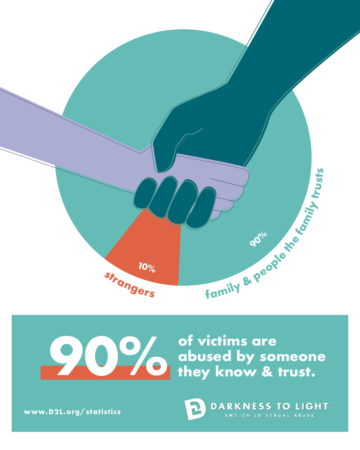In the 1980s, the American Medical Association distributed a widely viewed public safety announcement encouraging parents to teach their children about “Stranger Danger.”
In the 30-second clip, a man drives up to a young girl on her way to school. He begins a conversation with her and she responds, because her parents have “taught [their] children to be polite and friendly.” And then the narrator’s voice becomes more sinister. “But have you taught your children when not to be?”
 Over the last 40 years, children have learned not to approach unknown cars, take candy or gifts from unknown sources, and especially not to speak to strangers. But here’s the issue: Darkness to Light estimates that only around 10% of victims of child sexual abuse are abused by a previously-unknown adult. Approximately 90% of child sexual abuse victims know—and trust—their abuser.
Over the last 40 years, children have learned not to approach unknown cars, take candy or gifts from unknown sources, and especially not to speak to strangers. But here’s the issue: Darkness to Light estimates that only around 10% of victims of child sexual abuse are abused by a previously-unknown adult. Approximately 90% of child sexual abuse victims know—and trust—their abuser.
Statistically speaking, if a child is going to be sexually abused, the abuser is more likely to ingratiate themselves to the family in some way. By doing this, they stand to gain unsupervised access to the child. Experts refer to this process as grooming. Grooming provides a safety net for the abuser; as a trusted member of the child’s community, it’s hard to imagine (or perhaps admit) that they would be capable of doing harm. The abuser is often someone with easy access to children, maybe though youth sports, schools, other extra-curricular programs, or even the family.
So how do you keep your kids safe when the threat could be a familiar face? Teach them to trust their gut when something about a situation doesn’t seem right, even when that situation might include someone they know. Rather than simply instructing, “don’t talk to strangers,” teach them to recognize inappropriate behavior. This might be uncomfortable or unwanted touch, overly personal interactions, or asking to keep secrets. Encourage them to share with you when someone has displayed these behaviors or made them feel uncomfortable. When you and your children can recognize these behaviors, you’ll be able to make smart, informed decisions that keep your kids safe.
Above all, strengthen the protective bond between you and your children by recognizing your child’s feelings and needs, connecting through play, and encouraging them to talk and listening when they do. When your kids know you’re there for them, you help create a protective environment against abuse.
Want more resources? Click the links below.
How to be the Trusted Adult
Trusting Your Gut
Minimizing Opportunity for child sexual abuse
Follow us on social media to stay up to date and join the conversation.



